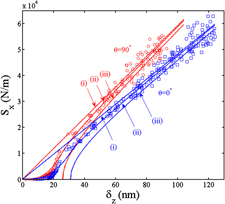Article contents
Mesoscale friction anisotropy revealed by slidingless tests
Published online by Cambridge University Press: 12 September 2011
Abstract

Using a recently developed multidimensional nanocontact system designed for a quantitative measurement of lateral contact stiffness in the 10–106 N/m stiffness range (or 10–1000 nm contact size), we found a crystallographic-orientation-dependent lateral-stiffness reduction relative to the elastic prediction at contact sizes around 50 nm for polished Ni single crystal surface in air. The slidingless measurement is enabled by a frequency-specific, continuous stiffness measurement technique. Based on an interface microslip model and an anisotropic elastic contact analysis, the resulting friction stress is found to increase monotonically when the tested lateral direction rotates away from the closely packed direction.
Keywords
- Type
- Materials Communications
- Information
- Copyright
- Copyright © Materials Research Society 2011
References
REFERENCES
- 6
- Cited by




